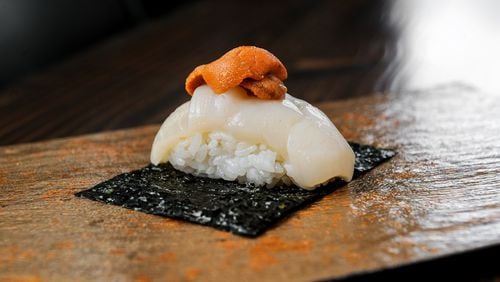Brush Sushi Izakaya
Overall rating: 2 of 4 stars
Food: Japanese
Service: best at sushi bar
Best dishes: nigiri, chawanmushi, otsumami
Vegetarian selections: some vegetable skewers, rolls and sides available
Price range: $$-$$$
Credit cards: all major credit cards
Hours: 5:30-11 p.m. Tuesdays–Thursdays, 5:30 p.m.-midnight Fridays and Saturdays, 5:30-10 p.m. Sundays; brunch served 11:30 a.m.-3 p.m. Saturdays and Sundays
Children: welcome, if they like raw fish
Parking: street and paid lot
Reservations: available for omakase by telephone
Wheelchair access: yes
Smoking: no
Noise level: low
Patio: no
Takeout: no
Address, phone: 316 Church St., Decatur. 678-949-9412
Website: brushatl.com
Go to Brush Sushi Izakaya, sit at the sushi bar and order the omakase. You will be very pleased. It is as simple as that.
Omakase is the Japanese equivalent of a tasting menu. It means something like “I trust you,” more or less a way of saying “chef’s choice.”
Those words give the chef a chance to say, “Forget the menu, I’ll just serve you the best I have right now.” If you have the time and money, why not listen? Especially at a sushi bar, where you may have the chance to sit directly across from the chef as each bite is cut and prepared. What could be better?
This is what I generally believe about sushi restaurants. Go to enough restaurants and any dining rule is proved wrong, though. Atlanta’s recent influx of high-end sushi bars have embraced the izakaya style, serving up small plates of fried, grilled and otherwise hot, prepared food. O-Ku on the westside, for example, is a place where I’d say forget the serenity of the sushi bar, grab a table, and order some plates to share.
Judging by the ambitions of the Brush menu, I expected that the omakase rule might not apply. This is, as far as I can remember, the most ambitious izakaya-styled menu I’ve seen in Atlanta. Wagyu gyoza! Bicho-tan charcoal! Snow crab chawanmushi! Pork and chicken yakitori with meat as carefully sourced as the yellowfin tuna! Not just a seaweed salad, but an assortment of distinct seaweeds! This is the kind of exciting menu that, if executed well, would be in no need of a chef’s intervention.
As I found out, Brush proves the omakase rule by a long shot. Before I get into all of that, let me tell you what happened when I dropped in on a recent Friday night.
It was busy, of course, as is nearly every restaurant near the square in downtown Decatur on Friday night. I didn’t have a reservation, but I managed to snag a seat at the far end of the bar. I ordered a draft Sapporo, nothing special, and the mid-range omakase, which runs $98.
Across the bar from me, I spied chef Jason Liang, in black chef’s coat to contrast to his peers’ white coats. The restaurant bustling and tables full, he gave no indication of hurry, instead moving confidently, carefully, setting his long Japanese blade down between cuts of fish. He began to prepare the otsumami, an assortment of small bites much like the amuse-bouche in any tasting menu, by warming a medallion of monkfish over a small, tabletop box of charcoal.
In a small bowl, he set a rectangle of creamy, outrageously rich uni-tofu and topped it with a tiny spoonful of UGA sturgeon caviar. One plate held a simple, tender hunk of octopus. In another, flakes of marinated, deeply savory tuna. Just before he passed this menagerie of bites across the bar, he plucked the monkfish liver medallion from the charcoal. When I took a bite, the warmth of the liver was exactly right: still holding its shape, but ready to melt away on my tongue.
The rest of the meal progressed this way. Slow, careful and exquisite.
Liang is not particularly social at the sushi bar. He doesn’t waste much time shaking hands. Yet, he still found moments to explain details such as the unusual technique required to cut gizzard shad (one of the night’s standout pieces of nigiri), the number of days a cut of fish had been aged, that the dashi in the chawanmushi was made in-house.
This was punctuated with the occasional surprise: a disc of pickled rhubarb, just as good, maybe even better, than the house-pickled ginger. A bowl of miso soup loaded with a few salty, pleasant clams. A dab of fresh wasabi, grated right from the root atop cuts of sashimi.
Liang exhibited the controlled enthusiasm of a chef proud of and still interested in his own skills. When complimented on the distinct tang of the vinegar in his rice, a genuine smile spread across his face. There were several notable distinctions to his nigiri, not the least of which was the very generous portion of his cut and the light brush of soy he applied to each bite.
I drank only Sapporo that night, in part because I prefer a simple, clean accompaniment to an elaborate meal like that. Brush does offer an impressive drink program — not just the predictable sake, but interesting wines, like a glass of Dirty and Rowdy Familiar Blanc, and excellent cocktails like the warm, tea-like Totoro sake cocktail, served in a pot.
I explored those drinks on a quieter night, a Tuesday when the restaurant was half-full. It was an uneven experience. Certain dishes, like the chawanmushi and a salmon tataki plate glittering with salmon roe and a bright, fruity mince of Asian pear, were as fine as anything in that omakase.
But many dishes were uneven. Much of the yakatori skewers we ordered were missing the caramelization that binchotan charcoal should deliver. Fried oysters were heavily breaded and cooked to a dark, heavy brown, the opposite of what I desire in an oyster. The nigiri was good, but the knifework was imprecise in a way that would not happen with Liang’s knife.
Though the service was friendly and more or less attentive, the folks delivering our food didn’t seem to be trained to know — or to share any passion for — the food the way Liang does.
Of course, our waitress had been trained to deliver that familiar opening monologue “about the menu” and restaurant, one of the most common and useless moments in any restaurant today. I’d much rather have heard a tidbit of knowledge or insight about the selection of unusual seaweeds, an interesting dish that would have been more interesting if I’d known what I was eating.
Alas, it is rare to find anyone who can convey a passion for food the way a chef can. That’s why the omakase rule is so often right. There are few seats at Brush where you can have such an experience, but you will be rewarded if you get one.






